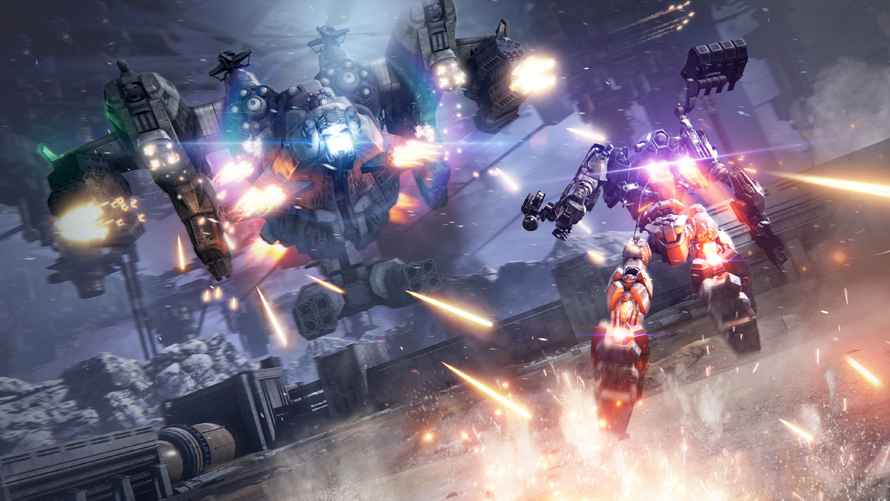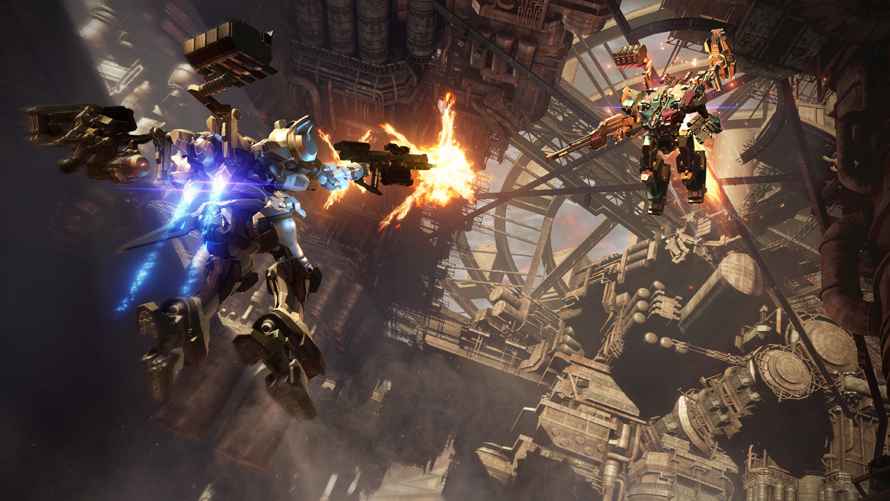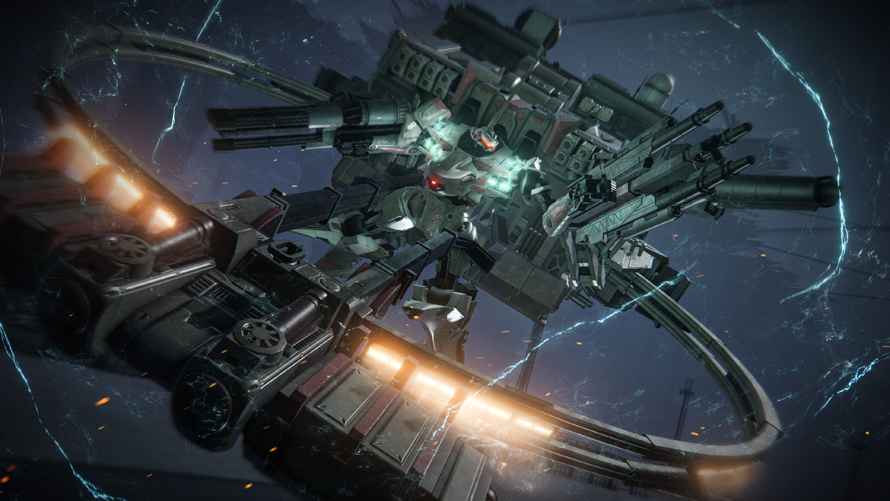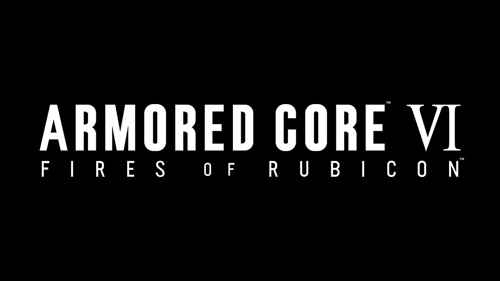Armored Core VI: Fires of Rubicon Review
There are two broad categories of gamers that will find their way to Armored Core VI: Fires of Rubicon. The first consists of those fans of franchise — surprisingly legion and rabidly enthusiastic — who have been waiting a decade for the developer to return to the series. The other, and much larger, group of gamers are those who have become ensnared by the magic of FromSoftware via Dark Souls, Bloodborne, and especially, Elden Ring. The question is whether Armored Core VI can serve both groups equally well.
Unsurprisingly the answer is yes. But it’s a nuanced yes. FromSoftware is at the top of their already stellar game, and Armored Core VI is a brilliant and evolutionary return to the beloved series. It’s also as welcoming as it can be to newcomers. Still, AC VI might not be a game for the masses. Aside from Elden Ring’s beginner-friendly elements, FromSoftware games have always had a steep price of entry, happy to exchange some blood, sweat, and tears for the unmatched feeling of beating a boss or even just making progress. Armored Core VI is no different.
Say It Again
Get ready to read or hear this in every review: Armored Core VI is not Dark Souls with mechs. It’s obvious, but it’s also important. The game’s combat mechanics are fine-tuned to an almost astonishing degree, the environments and enemies are often spectacular, but it isn’t a game filled with mysterious men and women, Lovecraftian monsters, or incremental increases in power. Where Armored Core VI most reflects the developer’s consistent philosophy is in the tension between perseverance, skill, and ultimate reward. It’s the — pun intended — core of ACVI, as it is in every recent FromSoftware title.

There are many Dark Souls fans who have forgotten, or never knew, that FromSoftware largely made a name for itself with the Armored Core franchise. What’s fascinating is that some of the early Armored Core design philosophies made their way into Dark Souls. And now, ten years of refining Souls-related games have allowed FromSoftware to create the best game — by far — in the AC franchise. In other words, AC VI is not Dark Souls with mechs, but AC VI would not exist in its present form without Dark Souls.
Shades of Grey
Armored Core VI: The Fires of Rubicon is a mech fighting game. Instead of slow and lumbering mechs, this is a world of agile, powerful, and infinitely customizable machines. Combat is aggressive, often chaotic, and always tactical. If it feels like under all the steel and pistons two nimble ninjas are fighting, it could be because the director was responsible for Sekiro.
You play as a nameless mercenary, C4-621, a human who has been surgically augmented to control a mech and a range of interchangeable parts. You have been sent to the planet Rubicon 3 to fight for various conflicting corporations and factions. Primarily, these are Balam Industries, Arquebus Corporation and their subsidiaries. A mysterious and powerful resource called Coral is at the heart of the conflict. Coral is powerful enough to ignite an entire planetary system, so stakes are high. There are other factions, like the Rubicon Liberation Front, with the goal of undermining the corporations’ mining of Coral.
Players uncomfortable with moral ambiguity in their narratives might squirm a bit with AC VI’s story. Your character is willing to fight for anyone who pays, and to happily switch allegiances as needed. There are no good guys and bad guys. You and your fellow mercs are both, and neither.

Told almost entirely via radio headset communications, the story certainly escalates in drama and complexity. The stakes get higher as the conflict grows more nuanced. However, while it becomes more engaging, the jargon-filled narrative is the least successful element of Armored Core VI, though it’s entirely consistent with the setting and theme. Players may find themselves skipping through a lot of it, but then, FromSoftware games always have essentially optional stories. The story is worth exploring, but the game’s action is the focus.
Pure Genius
Combat in Armored Core VI is, to use a highly technical term, crazy good. This level of perfection comes from a combination of two elements: the implementation of the customizable mechs, and their relationship to level design, pacing, and enemy encounters. The developers state that AC VI is built on a gameplay loop of two equal parts. The first is assembling and upgrading your mech. The second is throwing your design into combat, failing, and then returning to the garage, lessons learned. You’re not expected to be immediately successful, but to hit wall after wall, until you figure out the solution. And, like in every FromSoftware game, the tools are there to help you succeed.
Success in combat comes down to changing your mech to fit the circumstances. To this end, the game gives you an insane amount of control over every part of your mech. Not just the weapons, but the head, arms, legs, torsos, power supply, and circuit boards under the hood. Between all the options for changing gear and cosmetics, AC VI provides an unheard-of level of customization.
While AC’s jargon might be different, experienced roleplaying gamers will still find equivalent stats for stamina, strength, hit points, and damage. While it has a deep system for customization with endless ways of swapping builds, the base concepts are not hard to understand.

Balance Sheet
And, as in most RPGs, changing gear is a series of balanced tradeoffs. Agility is at the cost of power or defense, strength is at the cost of nimble movement. Because mechs in AC VI move in 360 degrees, the ability to fly or to hover is often as important as speed on the ground. Reverse-jointed legs work great for scaling walls and staying in the air a little longer. Tetrapod legs can hover. Tank legs provide a massive defense boost, though increase encumbrance when lifting off. Every exchangeable part has important advantages in some situations and becomes a liability in others.
Parts are bought and sold in the shop, and they’re unlocked by completing missions, paid for by coin earned in combat. Additionally there is a mechanic called OS Tuning which unlocks character upgrades like faster reloading, a powerful kick, and many more. These are paid for by OS Chips, earned in the game’s PvP or PvE Arena. Parts are bought and sold for the same price, so there’s no cost penalty for trying new gear.
Lock and Key
At some point, players need to exit the garage and move on to a mission. Armored Core VI is not an open world, but strictly mission based. Some of the missions are very short and others — like the massive, Titan-like mining rig encounter in the first chapter — are essentially multi-stage boss battles in disguise. All are repeatable for a higher rating and extra coin. Dying means restarting a level, or optionally starting at a checkpoint, taking a small hit on your earnings. There are no leftover piles of souls to retrieve. On the other hand, you only have three repair kits and checkpoints are widely spaced. Thankfully, a supply drop usually replenishes ammo and healing before a boss.
If you’ve played other FromSoftware games, you’ve experienced the mechanic of an at-first insurmountable mini-boss in one level showing up again in the next as a lower-level enemy. Nearly every mission in AC VI is based on a specific type of new enemy mech for which you’re usually unprepared. While talented players might be able to brute force their way through, most mortals are expected to fail, return to the garage, and try again with a different Assembly. The game’s boss battles are no different, except they add infinitely more pattern recognition, precision and tactical awareness. The loop of build-try-fail is at the heart of Armored Core VI. Everything else is set decoration. If you don’t connect with the core loop, AC VI won’t be a good time.

Ain’t the Kind of Place to Raise Your Kids
Because Armored Core VI is a cross gen title, it — like Elden Ring — trades some current gen graphical sheen for great art direction that doesn’t rely on pure power. It’s awash in earth and metallic tones and generally set in industrial landscapes, but there are some jaw-dropping vistas, too. The action is so frenetic and full of color that you probably won’t notice that some textures are pretty simple. There were a few places where I was surprised by both a reminder of scale — the mechs seem nimble and diminutive but they actually tower over cars and freight — and by the lack of detail in the set dressing.
The campaign does a great job of creating as much variety as possible given the industrial, high-tech sci-fi setting. Not every mission takes place in giant factories or among the husks of destroyed refineries, but there is certainly less visual variation than in a typical hi-fantasy Souls game. That aside, the mechs and bosses look incredible, with complex combat animations that never grow repetitive.
Armored Core VI might have the best sound design of any recent sci-fi title. It’s incredibly precise and gives the player almost as much information as the UI. The music is likewise excellent. It’s otherworldly, grounded in recognizable acoustic instruments and orchestral textures but extended by electronics and industrial samples. And speaking of the game’s UI, it’s a model of clarity and simplicity.
So Much Game
Thanks to repeatable missions, the Arena, multiplayer matches and even training segments that offer significant rewards, Armored Core VI is full of content to explore. There are infinite ways to customize mechs, so if the combat and basic loop clicks, it’s hard to imagine the game ever going into the garage for good. After all, there are many fans still actively obsessed with AC IV and V.
Armored Core VI goes out of its way to explain itself to newcomers, and the first few hours do a good job of onboarding novices to the AC franchise. It works very hard to thread the needle between being a niche, hardcore game for devotees and a welcoming experience for Souls fans checking out the newest FromSoft game. Although it’s technically brilliant and absolutely bursting with energy, AC VI also feels a bit clinical. All the pseudo-military jargon and macho posturing in the headset don’t exactly humanize the story. Which, of course, is the point.

None of that’s a criticism, by the way. Armored Core VI has a strong identity and sense of its history. It rewards long-suffering AC gamers for their patience and will probably convert many players into fans. It’s proudly an Armored Core game, period.
There are many players who will want to jump into the PvP ASAP. As with all FromSoftware games, this is an aspect of Armored Core VI that will develop over time. Popular builds will come and go. Weapons will be nerfed and the competitive game will be balanced. The good news is that the netcode is extremely solid and smooth. The bad news is that the PvP matchmaking mechanics feel bare bones and very old school.
Just a Glimpse
Armored Core VI is not just fan service. It’s an incredible synthesis of a respected franchise and lessons learned over ten years of game design. For longtime players of Armored Core, the new game moves the series forward in a remarkably successful way. While it’s an entirely different experience, gamers coming from Dark Souls will still recognize FromSoftware’s core philosophy of challenge, persistence and reward. Armored Core VI is fast-paced, brutally difficult in places and extremely satisfying to play.
***PS5 code provided by the publisher for review***
The Good
- Incredible combat
- Infinite customization
- Outstanding art direction
- Great sound and music
- Immensely challenging
- The best AC game to date
The Bad
- Story is not always engaging
- Some simple textures
- Maybe too frenetic and technical for some

